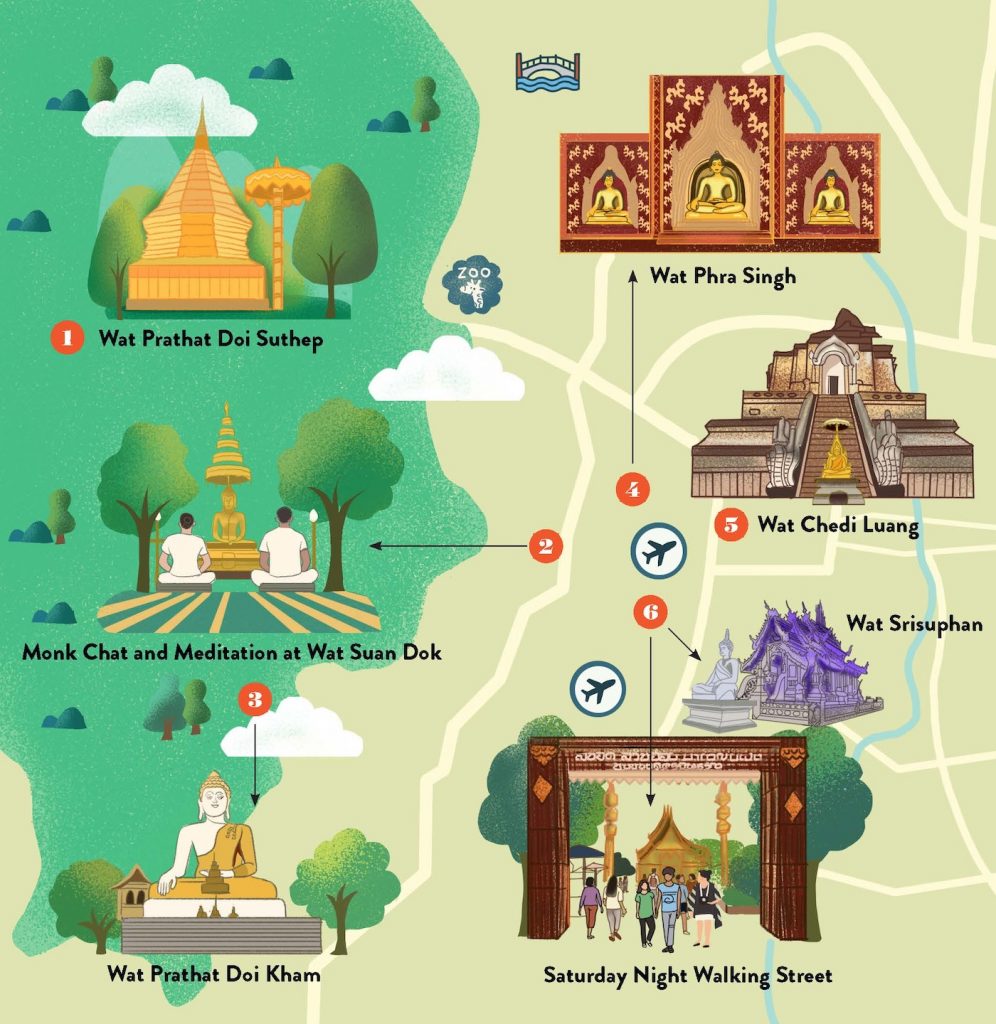With a population of just over one million, Chiang Mai is one of the largest cities in Thailand. This northern capital is known for its mountainous landscapes and diverse culture, in part due to its proximity to Laos and Myanmar. Historically, Chiang Mai was the center of a kingdom called Lanna (1291–1775). A Theravada Buddhist area with influences from Indian civilization and indigenous groups, Chiang Mai boasts over three hundred temples. To help narrow your options, here is a sampling of places to visit when traveling to this one-of-a-kind location.
1| Wat Prathat Doi Suthep
As the saying goes, “If you have not visited Wat Prathat Doi Suthep, you have not
really been to Chiang Mai.” The spectacular views of the city from this mountain temple make it a must-see for any traveler, but Buddhist travelers will be especially interested in its history. According to legend, a sacred white elephant carried a Buddha relic up the mountain through dense forest to the spot where the stupa was eventually built. But the temple is more accessible today thanks to the beloved monk Kruba Siwichai (1878–1939), who led the effort to build a road to it in 1935. Visitors can take a car, motorbike, or red taxi ride from the city up the mountain, or there is a scenic hiking path for those inclined.
Suthep, Mueang Chiang Mai District
2| Monk Chat and Meditation Program at Wat Suan Dok
Wat Suan Dok houses the country’s oldest Buddhist university, Maha Chulalongkorn Rajavidyalaya University (MCU). Since 2000, student monks pursuing their bachelor’s degrees at MCU have been involved with the Monk Chat and Meditation programs. In Monk Chat, students talk with curious English-speaking foreigners about Buddhism and monastic life. The Meditation program is introductory and tailored to foreign travelers. Monk Chat and Meditation also offer weekly retreats including half-day programs and overnight stays.
139 Suthep Rd., Thambon Su Thep, Mueang Chiang Mai District
3| Wat Prathat Doi Kham
Inside Wat Prathat Doi Kham, a temple on Kham Mountain, lies one of Thailand’s most famous wish-granting statues: Luangpor Tanjai. Whether or not you believe in the statue’s ability to hear your wishes, the wish-making ritual itself helps people clarify their aspirations, seek encouragement, and express gratitude. Thai tourists from provinces near and far visit the Luangpor Tanjai to make wishes for good luck, such as for better health or winning the lottery. After a visitor has achieved their goal, they return to the statue to offer jasmine garlands in thanks. This system creates a robust market for both lottery salespeople and jasmine garland sellers. Elsewhere on temple grounds, visitors can find huge standing and reclining Buddhas, as well as Hindu deities such as Siva, his wife Parvati, and the monkey god Hanuman.
Mae Hia, Mueang Chiang Mai District
4| Wat Phra Singh
Centrally situated in the old walled city of Chiang Mai, this temple sees thousands of visitors on Buddhist holidays—especially Visakha Puja Day, when observers circumambulate the stupa during the evening rituals. Within the temple, one hall holds traditional murals as well as a special Buddha statue called Phra Buddha Sihing, which, according to The Chronicle of the Sihing Buddha Image, arrived at the temple following a complex history of travel from Sri Lanka through the kingdoms of Thailand. The statue is flanked to the right by a mural of a folk story in the northern Lanna artistic style and to the left by a mural in the central Thailand style.
2 Samlarn Rd., Phra Singh, Mueang Chiang Mai District
5| Wat Chedi Luang
Running for a week in late May or June (depending on the lunar calendar), the celebration of the city pillar erected at the city’s founding, called Sao Inthakhin, is filled with fun, food, and traditional performances. Also known as the Flower Festival, this occasion sees participants spreading flowers in baskets around Sao Inthakhin in thanks to its protective powers. Chiang Mai is unique in that its city pillar is inside a temple: Wat Chedi Luang, known for its ancient stupa, which was originally constructed in 1481 and renovated in 1545 following an earthquake. Today, it stands at 282 feet high and 144 feet wide, the largest in the city.
103 Prapokkloa Rd., Tamon Si Phum, Mueang Chiang Mai District
6| Wat Srisuphan (Saturday Night Walking Street)
Every Saturday night, Wualai Road becomes a pedestrian thoroughfare filled with vendors selling food, crafts, clothing, and souvenirs. One of the distinctive arts of this walking street is silver. As this part of town keeps the tradition of silversmithing alive, silver engravings, decorations, and jewelry can be found up and down Wualai. Off a side street here lies Wat Srisuphan, also known by tourists as the “Silver Temple.” It features a beautiful all-silver ordination hall and a set of statues depicting the last ten lives of the Buddha with silver engraving. If you want to learn more, monks can teach you about the art of silversmithing in the temple workshop.
100 Wualai Rd., Haiya Sub-district, Mueang Chiang Mai District
Thank you for subscribing to Tricycle! As a nonprofit, we depend on readers like you to keep Buddhist teachings and practices widely available.
